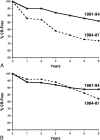Decreased acute rejection in kidney transplant recipients is associated with decreased chronic rejection
- PMID: 10522719
- PMCID: PMC1420898
- DOI: 10.1097/00000658-199910000-00005
Decreased acute rejection in kidney transplant recipients is associated with decreased chronic rejection
Abstract
Objective: To determine whether a recent decrease in the rate of acute rejection after kidney transplantation was associated with a decrease in the rate of chronic rejection.
Summary background data: Single-institution and multicenter retrospective analyses have identified acute rejection episodes as the major risk factor for chronic rejection after kidney transplantation. However, to date, no study has shown that a decrease in the rate of acute rejection leads to a decrease in the rate of chronic rejection.
Methods: The authors studied patient populations who underwent transplants at a single center during two eras (1984-1987 and 1991-1994) to determine the rate of biopsy-proven acute rejection, the rate of biopsy-proven chronic rejection, and the graft half-life.
Results: Recipients who underwent transplantation in era 2 had a decreased rate of biopsy-proven acute rejection compared with era 1 (p < 0.05). This decrease was associated with a decreased rate of biopsy-proven chronic rejection for both cadaver (p = 0.0001) and living donor (p = 0.08) recipients. A trend was observed toward increased graft half-life in era 2 (p = NS).
Conclusions: Development of immunosuppressive protocols that decrease the rate of acute rejection should lower the rate of chronic rejection and improve long-term graft survival.
Figures
References
-
- Matas AJ. Risk factors for chronic rejection—a clinical perspective. Transplant Immunol 1998; 6: 1–11. - PubMed
-
- Waaga AM, Rocha AM, Tilney NL. Early risk factors contributing to the evolution of long-term allograft dysfunction. Transplant Rev 1997; 11 (4): 208–216.
-
- Tullius SG, Tilney NL. Both alloantigen-dependent and -independent factors influence chronic allograft rejection. Transplantation 1995; 59: 313–318. - PubMed
-
- Halloran PF, Melk A, Barth C. Rethinking chronic allograft nephropathy: : the concept of accelerated senescence. J Am Soc Nephrol 1999; 10: 167–181. - PubMed
Publication types
MeSH terms
Grants and funding
LinkOut - more resources
Full Text Sources
Medical
Miscellaneous


